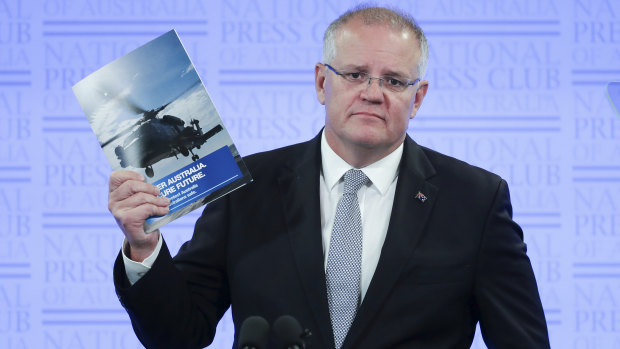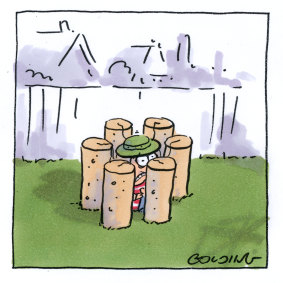This was published 5 years ago
Opinion
Raise taxes or find a new way of defending our country
Nicholas Stuart
Nic Stuart is a Canberra writer.If you think we aren’t heading, quite rapidly, towards a major budget crisis it simply shows you haven’t done the math.
Big picture stuff first. Let’s begin with the funding envelope, the taxes raised by government. So over to Prime Minister Scott Morrison who, as treasurer, insisted he’d never let taxes rise above 23.9 percent of gross domestic product. Great! ScoMo loves glib phrases like these, plucked from thin air. Totally meaningless (nearly half Peter Costello’s budgets failed this arbitrary marker) but marketing genius.

Prime Minister Scott Morrison addresses the National Press Club of Australia in Canberra.Credit: Alex Ellinghausen
He may also have a problem with his facts. Last month the conservative, Washington-based Heritage Foundation asserted that “over the past three years [Australian] government spending has amounted to 36.5 percent of GDP” and puts our public debt at 41.6 percent of GDP.
This means – leaving aside Morrison’s flawed understanding of economics – even by his standards there’s a lot of budget repair yet to be done.
Second, how about growing Commonwealth expenditure? Social security spending isn’t likely to fall abruptly, but neither is health, education, or disability care. In fact, it’s extremely difficult to imagine any significant spending areas will suddenly be returning significant dividends to the coffers. It’s about as likely as voters, or even more implausibly business, demanding higher taxes.
So what’s the crisis? Won’t we muddle along as always?
Well no, actually. Not as far as Defence goes, anyway.
Critical decisions are being taken today to re-equip the forces. That’s good. In Canberra today, attendees at Australian Defence Magazine’s seminal, comprehensive yearly congress are being treated to progress reports and detail of this extensive and elaborate building program.
There’s 72 Joint Strike Fighters, of course, coupled with (at least) six Triton Unmanned Aerial Vehicles and fifteen P-8 Poseidon’s. Eight Anzac frigates are being revamped and replaced with nine Hunter class vessels. We’ll have three air warfare destroyers sailing alongside two huge Landing Helicopter Docks. There are two significant patrol vessel programs underway, and Monday’s attempt to breath life into a project building twelve new submarines to replace the six Collins’. The army’s ambitious and energetic new chief, Lieutenant General Ric Burr, is also well aware new weapons systems are dramatically changing the very nature of warfare. To accompany replacement armoured vehicles he’ll need more equipment for missions we’re only just beginning to envisage today. Stuff like Black Hornet, a new nano-reconnaissance UAV the US is ordering for its infantry, together with ground-launched missiles.

89 per cent of Australians agree the world has become more dangerous.Credit: Matt Gplding
Wow! Look at the capability. Gasp at the cost.
None of this will come cheap.
It won’t surprise you, however, to discover that it’s usually the military with the best weapons systems that wins. This is why it’s important to have good ones – to save lives. Unfortunately, weapons can’t be replaced on a one-for-one basis. New equipment always costs (proportionately) more than what’s being replaced. Insisting on Australian builds further adds to cost, and then there’s the increasing danger of technological breakthroughs suddenly making what we’ve got redundant. There won’t be any savings coming from Defence.
Which brings us to the Australian Strategic Policy Institute’s Marcus Hellyer, whose conference presentation is titled, innocently enough, “The future of the defence budget”.
Sounds innocuous, really, doesn’t it? Harmless; a session to miss, maybe? Hardly.
What he’ll be saying should send shivers down the (missing) spines of politicians around the country. That’s because he’s done the numbers, attempting to reconcile projected equipment project costs with the cost of actually operating the new weapons.
As you’d expect, Hellyer’s careful and circumspect. No tabloid horror from him and he’s certainly not the type who seeks to make gratuitous headlines. He’ll insist, however, that “delivering the current equipment plan will cost considerably more than the current two percent of GDP that’s been allocated to defence”. The implications of such an anodyne statement are massive.
Take the future submarine, for example. Even if the ‘framework agreement’ signed on Monday is empty (it simply creates a basis for spending) we’re still shooting for the stars: 12 “regionally superior” boats to replace the six currently in the water. Really? All that extra lethality and capability will cost. They’ll also need a dozen crews, when we’re already having difficulty attracting enough submariners. We’ll have to pay sailors top-dollar to operate double that number of boats and the total cost of the new submarine flotillas will easily be more than double the current allocation. That’s without considering the extra size of the surface fleet. So where’s the money coming from?
Neither of the other services are shrinking and there are no plans to eliminate other capabilities, so the only possible conclusion is that the money will come from elsewhere.
Higher taxes, maybe, or cutting social security? I’m sure either of those would be palatable political options, aren’t you?
Both government and opposition are committing to lots of marvellous new equipment but nobody will say where the money to operate it is coming from.
Dangerously, committing such a large proportion of the budget to these projects limits future flexibility. What if we suddenly need to buy new weapons?
One thing’s dramatically obvious.
Three into two won’t go or, if you prefer, Defence’s current share of (nearly) two per cent of GDP won’t be nearly enough to run the future force.
So what’s it to be? Raise taxes or find a new way of defending the country?
Nicholas Stuart is a Canberra-based author.